The Southern Cross is a cross-shaped or kite-shaped asterism located in the constellation of Crux. The brightest star in Crux is also the brightest star in the Southern Cross asterism, namely, Acrux.
Key Facts & Summary
- The Southern Cross asterism is among the best-known asterisms in the southern hemisphere.
- It is often confused for the constellation of Crux as a whole, however, the Southern Cross is composed merely out of the brightest stars in Crux.
- The Southern Cross asterism is composed out of five bright stars, namely, Acrux, the brightest star in Crux, Mimosa, the second, Gacrux, Ginan, and Imai.
- The Southern Cross asterism is shaped as a cross, or as a kite. It holds special importance in Australia and New Zealand, where the constellation of Crux is circumpolar and can be seen throughout the year.
- The primary star of the Southern Cross, Acrux, is the 13th brightest star in the sky, and it is actually a multiple star system.
- The major star of the system, Acrux A, is a blue-white subgiant star located at around 321 light-years away.
- Acrux and Gacrux point the way to the Southern Celestial Pole.
- Gacrux is the nearest M-class giant star to us, located at only 88.6 light-years away. It has an apparent magnitude of +1.64, while Acrux has an apparent magnitude of 0.76.
- Observers in the tropical latitudes of the northern hemisphere can see the Southern Cross near the horizon, only in winter and spring, however, only for a few hours every night.
- Mimosa, the second-brightest star in Crux, is the 20th brightest star in the sky, having an apparent magnitude of 1.25.
- Mimosa, like Acrux, is also a multiple star system, with the primary component being located at around 280 light-years away from us.
- The faintest star in the Southern Cross is Ginan. This star is the fifth brightest in Crux, having an apparent magnitude of 3.58
The Southern Cross asterism is among the most recognizable star patterns in the southern hemisphere. It dominates the constellation of Crux, which is the smallest of the 88 modern constellations.
The constellation of Crux is associated with many stories and it figures prominently in several mythologies in the southern hemisphere. Crux means cross in Latin, and the ancients considered this constellation to be part of the greater Centaurus constellation.
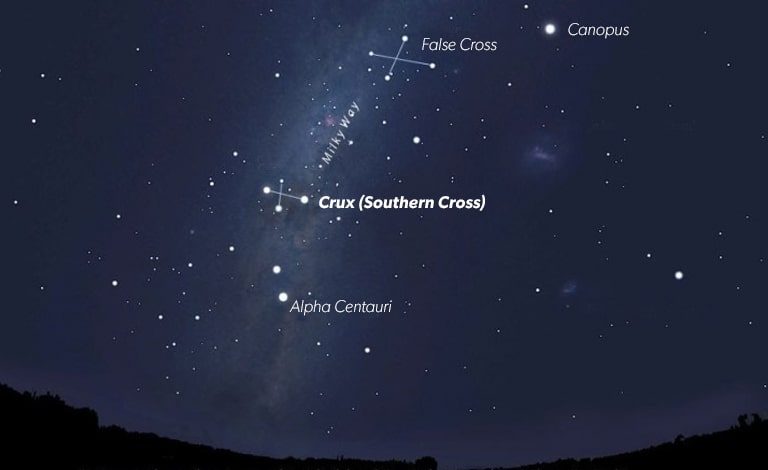
It was only in 1679 that Crux became a constellation in its own right. The Southern Cross asterism gained great significance in many cultures with its five stars being represented on the flags of Australia, New Zealand, Papua New Guinea, Samoa, and Brazil. The Southern Cross is also included in the national anthems of both Australia and Brazil.
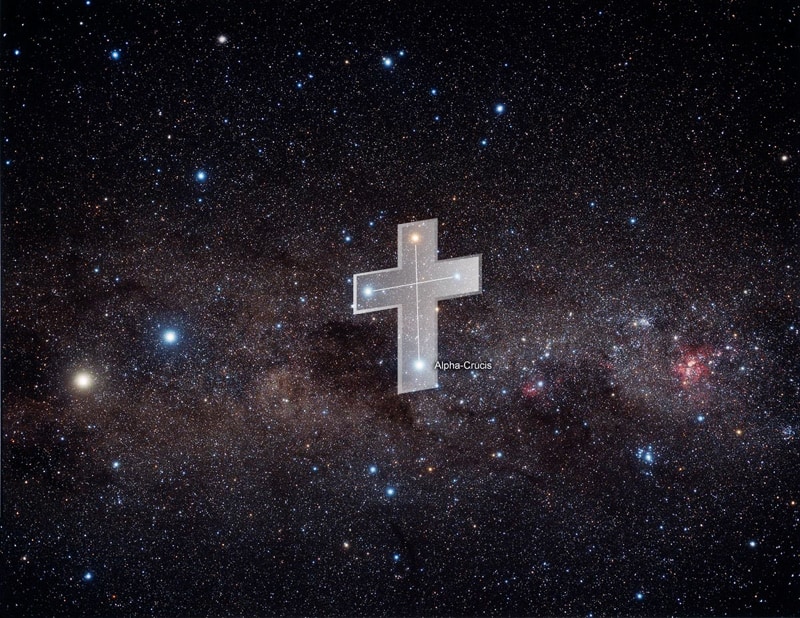
Location
The Southern Cross asterism is located in the constellation of Crux, which is the smallest out of the 88 modern constellations. Crux spreads out for around 68 square degrees in the sky.
Crux is not visible north of “20o in the northern hemisphere, and it is circumpolar south of 34oS, this means that it never sets below the horizon. On the celestial sphere, Crux is exactly opposite the constellation Cassiopeia.
- Right Ascension: 12.6h
- Declination: -60o
- Visible: +20o and -90o
- Best viewed: at 21:00 – 9 p.m. during May
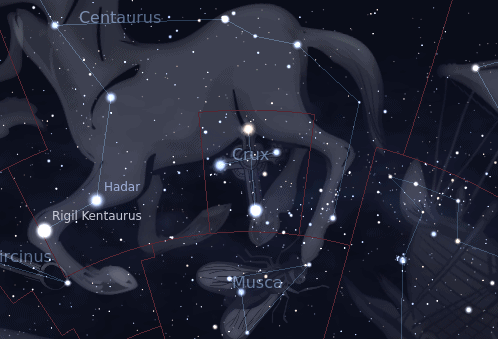
Crux is located in the third quadrant of the southern hemisphere (SQ3). The neighboring constellations around Crux are Centaurus and Musca.
Crux belongs to the Hercules family of constellations, along with Aquila, Ara, Centaurus, Corona Australis, Corvus, Crater, Cygnus, Hercules, Hydra, Lupus, Lyra, Ophiuchus, Sagitta, Scutum, Sextans, Serpens, Triangulum Australe, and Vulpecula.
The Southern Cross Stars
The brightest stars in Crux are the Southern Cross asterism stars Acrux, Gacrux, Imai, Mimosa, and Ginan. The brightest star in Crux is Acrux, having an apparent magnitude of 0.76.
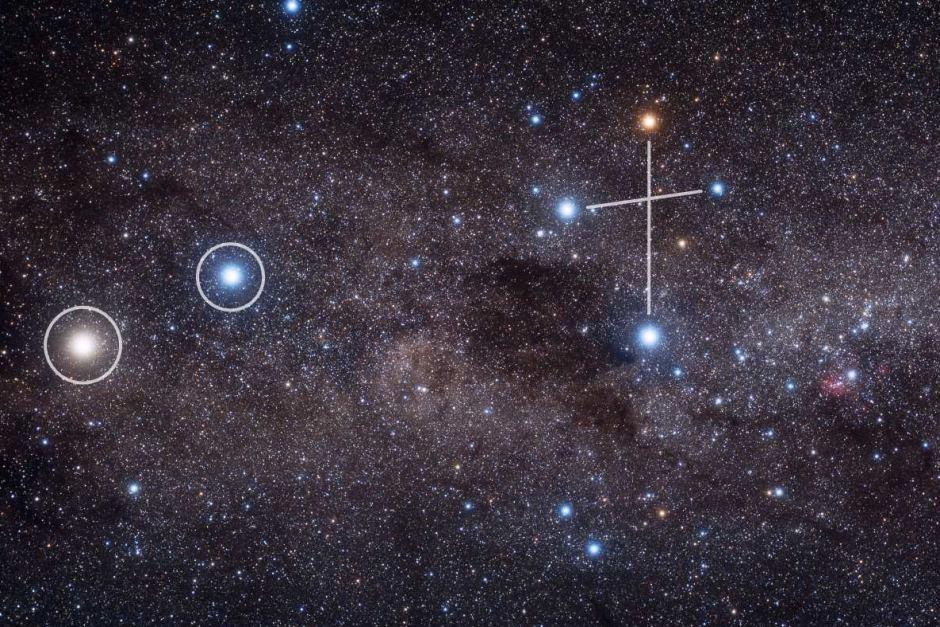
The brightest stars in the Southern Cross, Acrux, Mimosa, and Imai, are co-moving members of the Scorpius-Centaurus Association – a young association of stars from the constellations of Scorpius and Centaurus, that share a common proper motion, and are theorized to have formed inside the same molecular cloud.
Acrux
Acrux, also designated as Alpha Crucis, is the brightest star in the constellation of Crux, and the 13th brightness star in the night sky, however, it can also be the 12th due to its variability in brightness.
Acrux is a multiple star system, with the primary star being a blue-white subgiant star located at around 321 light-years away from the Sun. The secondary star is a blue dwarf.
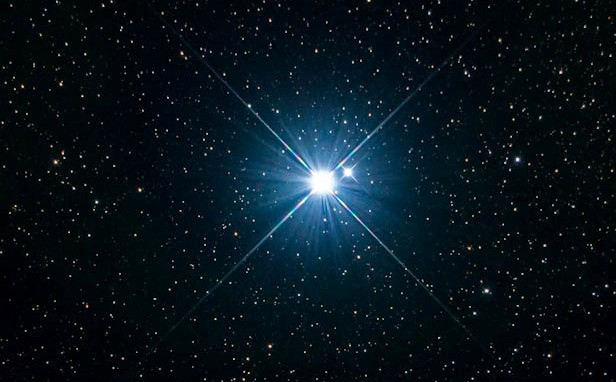
Acrux is 25,000 times brighter than our Sun, having 1780% of our Sun’s mass. The secondary star, Acrux B, has 1552% of our Sun’s mass, and it is 16,000 times brighter than our Sun.
Acrux A is several times bigger than our Sun, having 780% of our Sun’s radius, while Acrux B has 540% of our Sun’s radius. Both stars are several times hotter than our Sun, having surface temperatures of 24,000 K and 28,000 K, respectively. Acrux marks the bottom of the Southern Cross, and it can be seen around -63o declination, and it can only be seen south of latitude 27oN.
Mimosa
Mimosa, designated as Beta Crucis, and also known as Becrux, is the second-brightest star in the constellation of Crux, and the 20th brightest star in the night sky. Mimosa has an apparent magnitude of 1.25.
This star is a binary star, and a third component star is also suspected of being part of the system. Mimosa is located at around 280 light-years away from Earth.
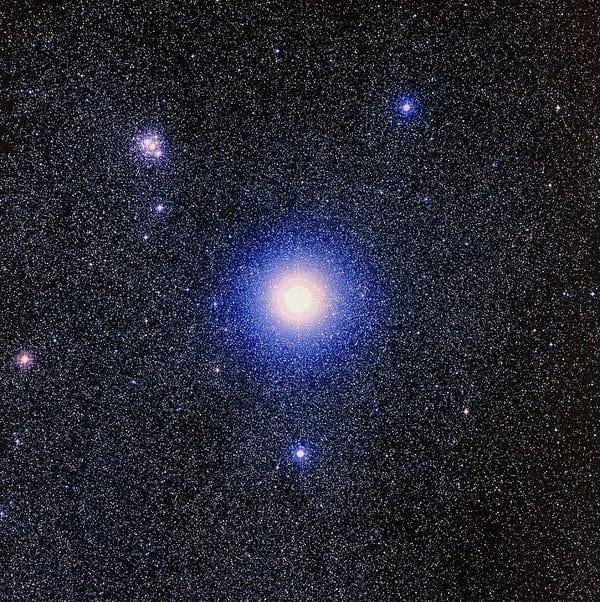
Mimosa is 34,000 times brighter than our Sun, having 1600% of its mass, and 840% of its radius. It is quite a young star, having an estimated age between 8 to 11 million years. Acrux and Mimosa are known as the Southern Pointers, since they, together with Gacrux, are used to find the South Celestial Pole. Mimosa can be seen at around -60o declination, and can’t be seen north of 30oN.
Gacrux
Gacrux, designated as Gamma Crucis, is the nearest M-class giant star to the Sun, located at around 88.6 light-years away. Gacrux is the third brightest star in the constellation of Crux, and the 25th brightest star in the night sky.
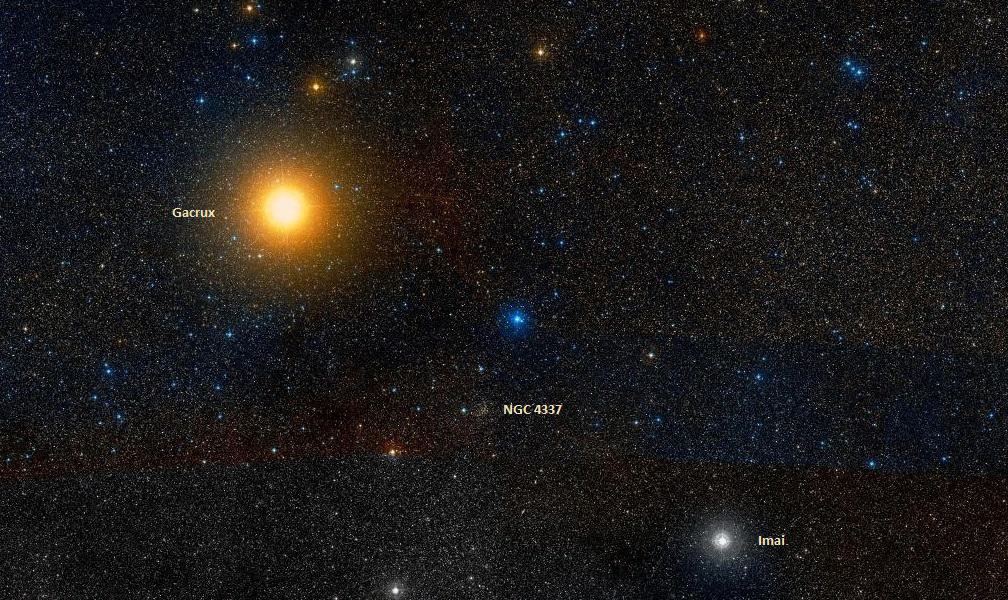
Gacrux is around 820 times brighter than our Sun, having 150% of our Sun’s mass, and 840% of its radius. Gacrux is the brightest star of its class in the sky, and the nearest red giant to the solar system. Gacrux has an apparent magnitude of +1.64. Gacrux is the closest star out of the Southern Cross asterism to us.
Imai
Imai, designated as Delta Crucis, it is the fourth brightest star in the constellation of Crux. Imai is a blue-white subgiant star with an apparent magnitude of 2.79.
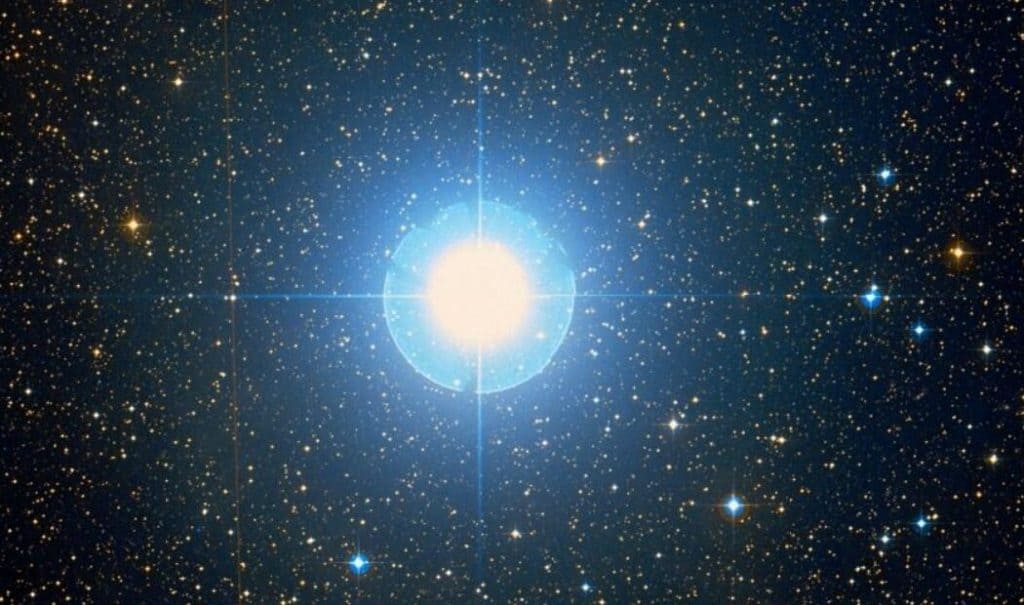
Imai is located at around 345 light-years away from us. It is 10,000 times brighter than our Sun, having 890% of its mass, and 800% of its radius.
Imai has an effective temperature of around 22,570 K. It is a candidate Beta Cephei variable, exhibiting subtle changes in brightness over 3.7 hours. Imai is a fast-spinning star with a rotational velocity of around 210 km / 130.4 mi per second.
Ginan
Ginan, designated as Epsilon Crucis, is an orange-hued star located at around 230 light-years away from us. Ginan has an apparent magnitude of 3.58, being the fifth brightest star in the constellation of Crux.
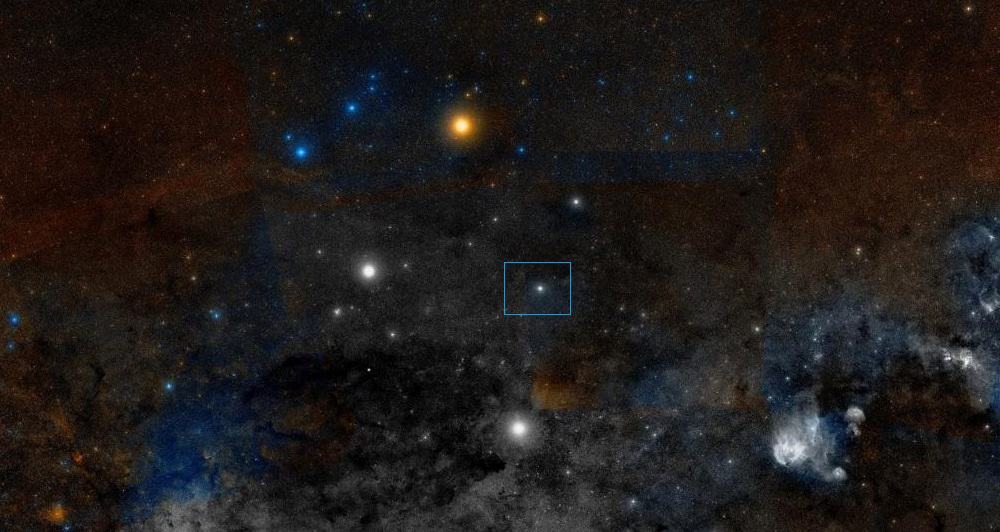
Ginan is 302 times brighter than our Sun, having 152% of its mass, and around 2841% of its radius. It is evolving away from the main sequence and thus it will continue to expand. The five stars of the Southern Cross are believed to be between 10 and 20 million years old – much younger than our Sun.
Using the Southern Cross
The Southern Cross asterism can be used to find the location of the Southern Celestial Pole, just like the brightest stars in Ursa Major are used to find the North.
The longer bar of the cross-shaped asterism points towards the South Pole in the sky. Aviators and sailors sometimes refer to this point as the “south polar pit” since no bright stars are marking it.
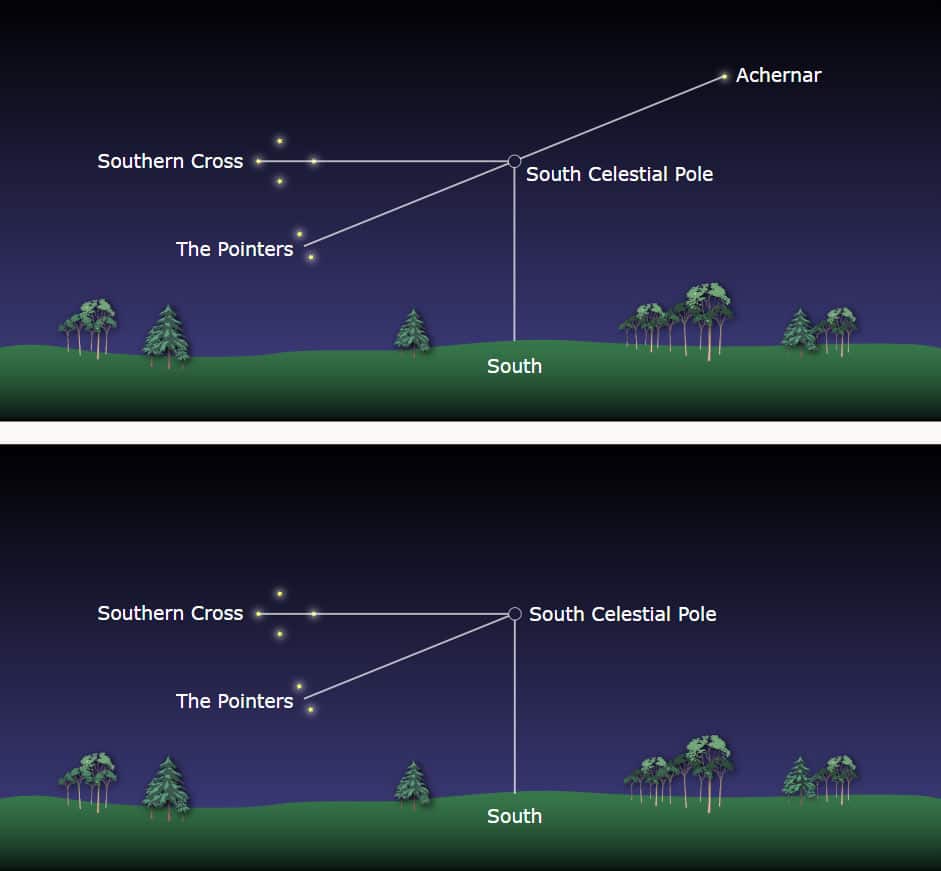
The Southern Celestial Pole can also be located by drawing a line between the stars Alpha and Beta Centauri in Centaurus constellation. Then, you have to find the point where this line intersects with the one from Alpha Crucis – Acrux, and Beta Crucis – Mimosa.
Did you know?
- The Southern Cross was an important symbol for the Egyptians, as it represented the place where Horus, the Sun-goddess, was crucified, marking the passage of winter.
- The Aborigines and Maori saw the Southern Cross as symbolizing animist spirits that were integral in their ancestral beliefs. The Aborigines saw Crux and the Coalsack Nebula as marking the head of the “Emu in the Sky”.
- A depiction of the Southern Cross was discovered on a stone engraving in Macchu Picchu.
- The Incas knew the Southern Cross as “Chakana” – stair – and it played an important part in Incan mysticism, symbolizing the three tiers of the world: the heavens, the world of the living, and the underworld.
- The Southern Cross was visible in the northern hemisphere around 5,000 years ago. People in most of North America, Babylonia, and Greece could view it easily.
- One of the earliest recordings of the Southern Cross was found in Greece around 1000 BC. The Ancient Greeks considered Crux to be part of the greater Centaurus constellation.
- In the year 400 AD, the constellation of Crux was invisible for most of Europe, and thus the Europeans did not rediscover Crux until the great naval expeditions of the late 15th and early 16th centuries.
Sources:
Image Sources:
- https://lawnsolutionsaustralia.com.au/wp-content/uploads/2020/05/SouthernCross.jpg
- https://in-the-sky.org/images/constellations/con_CRU_000.png
- https://www.abc.net.au/science/starhunt/images/slideshow/Southern-Cross/scross_01.jpg
- https://www.abc.net.au/news/image/9779624-3x2-940x627.jpg
- https://www.astronomytrek.com/wp-content/uploads/2017/05/Acrux.jpg
- https://nineplanets.org/wp-content/uploads/2020/01/Gacrux-Imai-and-NGC.jpg
- https://www.star-facts.com/wp-content/uploads/2020/07/Mirzam-1050x620.jpg?189db0&189db0
- https://nineplanets.org/wp-content/uploads/2020/01/optical-image-of-the-star-mimosa-or-beta-crucis-celestial-image-co.jpg
- https://www.star-facts.com/wp-content/uploads/2019/10/Ginan.jpg?189db0&189db0
- https://teara.govt.nz/files/7486-enz.jpg
